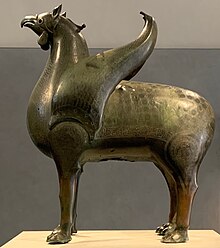
The Pisa Griffin is a large bronze sculpture of a griffin, a mythical beast, that has remained in Pisa, Italy since the Middle Ages despite its Islamic origin, specifically late 11th or early twelfth century Al-Andalus (Islamic Spain).[1] It is now in the Museo dell'Opera del Duomo (Cathedral Museum) in Pisa.
Carbon dating has determined that the griffin was made sometime between 1085 and 1110 AD.[2][page needed] The Pisa Griffin is the largest medieval Islamic metal sculpture known, standing over three feet tall at 1.07 metres (42 in). It has been described as the "most famous as well as the most beautiful and monumental example" of a tradition of zoomorphic bronzes in Islamic art.[3]
The griffin seems at first a historical anomaly given its elusive origin and multiplicity of possible uses, including a fountainhead or musical instrument. However, its possible origin can be approximated by comparing it to similar sculptures of its time, namely the animalistic sculptures and fountains of Al-Andalusian palatial settlements. Furthermore, the griffin may share a similar method of construction, and therefore origin, as the Al-Andalusian fountainheads based on the metallic contents of its bronze alloy.